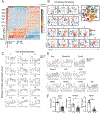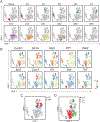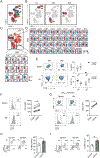Early precursors and molecular determinants of tissue-resident memory CD8+ T lymphocytes revealed by single-cell RNA sequencing
- PMID: 32414833
- PMCID: PMC7341730
- DOI: 10.1126/sciimmunol.aaz6894
Early precursors and molecular determinants of tissue-resident memory CD8+ T lymphocytes revealed by single-cell RNA sequencing
Abstract
During an immune response to microbial infection, CD8+ T cells give rise to distinct classes of cellular progeny that coordinately mediate clearance of the pathogen and provide long-lasting protection against reinfection, including a subset of noncirculating tissue-resident memory (TRM) cells that mediate potent protection within nonlymphoid tissues. Here, we used single-cell RNA sequencing to examine the gene expression patterns of individual CD8+ T cells in the spleen and small intestine intraepithelial lymphocyte (siIEL) compartment throughout the course of their differentiation in response to viral infection. These analyses revealed previously unknown transcriptional heterogeneity within the siIEL CD8+ T cell population at several stages of differentiation, representing functionally distinct TRM cell subsets and a subset of TRM cell precursors within the tissue early in infection. Together, these findings may inform strategies to optimize CD8+ T cell responses to protect against microbial infection and cancer.
Copyright © 2020 The Authors, some rights reserved; exclusive licensee American Association for the Advancement of Science. No claim to original U.S. Government Works.
Conflict of interest statement
Figures






References
-
- Sallusto F, Lenig D, Forster R, Martin L, Lanzavecchia A, Two subsets of memory T lymphocytes with distinct homing potentials and effector functions, Nature 401, 708–712 (1999). - PubMed
Publication types
MeSH terms
Grants and funding
- R01 AI100880/AI/NIAID NIH HHS/United States
- R01 AI123202/AI/NIAID NIH HHS/United States
- R01 AI129973/AI/NIAID NIH HHS/United States
- P30 DK120515/DK/NIDDK NIH HHS/United States
- KL2 TR001444/TR/NCATS NIH HHS/United States
- I01 BX003424/BX/BLRD VA/United States
- T32 DK007202/DK/NIDDK NIH HHS/United States
- R01 AI082850/AI/NIAID NIH HHS/United States
- P01 AI132122/AI/NIAID NIH HHS/United States
- P30 CA023100/CA/NCI NIH HHS/United States
- R01 GM124494/GM/NIGMS NIH HHS/United States
- P30 DK063491/DK/NIDDK NIH HHS/United States
- U19 MH107367/MH/NIMH NIH HHS/United States
LinkOut - more resources
Full Text Sources
Other Literature Sources
Molecular Biology Databases
Research Materials

